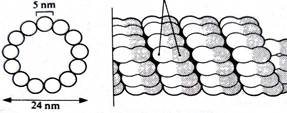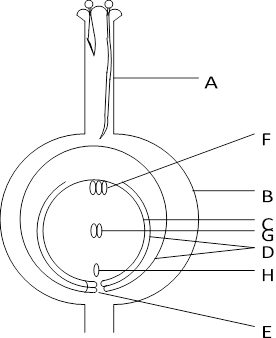THE UNITED REPUBLIC OF TANZANIA PRESIDENT’S OFFICE, REGIONAL ADMINISTRATION AND LOCAL GOVERNMENT

NJOMBE REGION
FORM SIX PRE-MOCK EXAMINATION
CODE: 133/2 BIOLOGY 2
TIME: 3:00 HRS Wednesday, 23 rd August 2023 P.M
INSTRUCTIONS
- This paper consists of six (6) questions.
- Answer five (5) questions.
- Each question carries twenty (20) marks.
- All writing must be in blue or black ink except drawing which must be in pencil.
- Cellular phones and any unauthorized materials are not allowed in the examination room.
- Write your Examination Number on every page of your answer sheets.
| FOR EXAMINER’S USE ONLY | |||
| QUESTION NUMBER | QUESTION ATTEMPTED PUT A TICK(V) | ||
| MARKS | EXAMINER’S SIGNATURE | ||
| 1 | |||
| 2 | |||
| 3 | |||
| 4 | |||
| 5 | |||
| 6 | |||
| TOTAL MARKS | |||
| CHECKER’S INITIALS | |||
Answer any five (5) questions.
1. a) Explain with examples, why bacteria are said to be successful colonizers. Give four points.
b) Give reason as to why some taxonomists consider Protoctista as an obsolete Kingdom.
c) Explain the adaptations of Dryopteris to its mode of life. Give five points
2. a) What advantages do mammals have in using urea as a nitrogenous waste product? Give four points.
b) Explain why in cold weather, human produce more dilute urine than in hot weather.
c) The renal corpuscle is highly modified for the process of ultra-filtration. In five points support this statement.
3. a) With the aid of illustration, explain why insects exhibit a unique growth curve.
b) Explain two types of seed dormancy and state causes of each type.
4. a) i) DNA is termed to be the most favorable genetic material. Give four reasons.
ii) Briefly explain the evidence to support the idea of hereditary material being located in the nucleus. Give three points
b) Differentiate between DNA and RNA molecule. Give three points.
5. a) With examples, give an account on how economic development activities can alter ecosystem. Give six points
b) Population of any place is dynamic and not static. Explain four (4) factors that cause this phenomenon in any area.
6. a) Briefly explain the following terms;
i. Microevolution
ii. Selection pressure
b) Briefly explain four (4) mechanisms that operate to bring about natural arise of new species.
FORM SIX BIOLOGY EXAM SERIES 69
FORM SIX BIOLOGY EXAM SERIES 69
THE UNITED REPUBLIC OF TANZANIA

PRESIDENT’S OFFICE, REGIONAL ADMINISTRATION AND LOCAL GOVERNMENT
NJOMBE REGION
FORM SIX PRE-MOCK EXAMINATION
CODE: 133/1 BIOLOGY 1
TIME: 3:00 HRS Monday, 21nd August 2023 P.M
![]()
INSTRUCTIONS
• This paper consists of ten (10) questions with two Sections, A and B
• Answer ALL question from section A and only two (02) question from section B
• Except for diagrams that must be drawn in pencil all writing should be done using a blue or black pen.
• Cellular phones are not allowed in the examination room
• Write your examination number on every page of your answer sheet(s)
| QUESTION NUMBER | QUESTION ATTEMPTED PUT A TICK(V) | FOR EXAMINER’S USE ONLY | |
| MARKS | EXAMINER’S SIGNATURE | ||
| 1 |
|
|
|
| 2 |
|
|
|
| 3 |
|
|
|
| 4 |
|
|
|
| 5 |
|
|
|
| 6 |
|
|
|
| 7 |
|
|
|
| 8 |
|
|
|
| 9 |
|
|
|
| 10 |
|
|
|
| TOTAL MARKS |
|
|
|
|
| CHECKER’S INIT | IALS |
|
SECTION A (70 MARKS)
1. a) While analyzing the cytoplasm of animal and plant cells, a scientist encountered the structure in figure 1 bellow. They were very fine, unbranched, hollow tubes with an external diameter of about 24nm and walls about 5nm thick made up of helically arranged protein subunits.

Figure 1
i. Identify the structure
ii. Enumerate any five functions played by the structure to the cell
b) Describe the difference in molecular structure between cellulose and Starch
2. a) Precisely, what role does oxygen perform in cellular respiration?
b) Name four chemical substances which are involved in respiration which would enter the mitochondrion from the cytoplasm and four which would leave.
3. a) A group of young farmers from Njombe-Tanzania were planning to order new mango seeds from Venezuela for their plantation. While writing down the order, their advisor told them to use the name Mangifera indica instead of Mango. What do you regard as a scientific advantage of such an advice?
b) Figure 2 consists of heads and beaks of four birds labeled Bird W, Bird X, Bird Y and Bird Z. Use the key provided to identify each bird by writing down the number of the true statement for the bird until you arrive at the correct name.

Figure 2 THE KEY
1 a) The beak is relatively long and slender……………………Certhidea
1 b) The key is relatively stout and heavy………………………go to 2
2 a) The bottom surface of the lower beak is flat and straight…. Geospiza
2 b) The bottom surface of the lower beak is curved …………. Go to 3
3 a) The lower edge of the upper beak has a distinct bend…Camarhynchus
3 b) The lower edge of the upper beak is mostly flat………... Platyspira
4. a) The number of chromosomes in the radicle of a certain species of flowering plant is to be 16. Evaluate the number of chromosomes in the following cells:
i. Pollen tube nucleus
ii. Endosperm
iii. Antipodal cell
iv. Microspore mother cell
b) Draw a large, neat and well labelled diagram of human secondary oocyte.
5. a) What are the major three (3) light dependent reactions of photosynthesis?
b) Briefly and precisely, explain why surgical removal of the stomach in human is not necessarily fatal.
6. a) With the help of a diagram, briefly describe the structure of a membranous labyrinth.
b) Name the hormone that is most likely to produce the desired effects in each of the following.
i) A farmer wants to ripen his oranges rapidly so as to meet the demands of a new market.
ii) A Biology teacher wants to demonstrate that a dwarf variety of Maize plant can be made to grow to normal size.
iii) A farmer wants to initiate and stimulate roots development in his cuttings before planting them
iv) A farmer wants to prolong shelf life of his cabbages to prevent decay/rotting.
7. Most of farmers in Tanzania use seeds as a propagation technique for producing most of cash and food crops. What do you think are the advantages and disadvantages of reproducing by seeds as compared to other techniques? (Five points in each case).
SECTION B (30 MARKS)
Answer any two (02) questions from this section.
8. a) i) Dioecious plants are rare, despite the advantage of cross pollination. Suggest two possible reasons for this
ii) Dioecism (separate sexes) is common in animals. Suggest why this phenomenon is more successful in animals than in flowering plants.
b) The human placenta is generally referred to as the site for exchange of material and a barrier against entry of toxic and harmful materials from maternal to the fetus. However, there are some harmful substances that may cross the placenta to the fetus. Briefly explain any five harmful substances that may cross the placenta to the fetus.
9. a) What is the biological significance of the properties of water?
b) What structural features of carbohydrates account for the fact that a wide variety of polysaccharides exists.
10. a) What are the important features of phloem transportation?
b) The heart being made up of cardiac muscles, beats powerfully and continuously throughout the entire life without any rest. Explain how the cardiac muscles incredibly manage that activity.
FORM SIX BIOLOGY EXAM SERIES 68
FORM SIX BIOLOGY EXAM SERIES 68
TANZANIA HEADS OF ISLAMIC SCHOOLS COUNCIL
FORM SIX INTER ISLAMIC MOCK EXAMINATION
BIOLOGY 2
133/2 (For both School and Private Candidates)
TIME: 3 HOURS Thursday, 09th March 2023 p.m.
Instructions
1. This paper consists of six (6) questions.
2. Answer only five (5) questions.
3. Each question carries twenty (20) marks.
4. Cellular phone and any unauthorized materials are not allowed in the examination room.
5. Write your Examination Number on every page of your answer booklet(s)
1. (a) Controlling potato blighting is one of the ways of improving quality for the farmers which seems to be a big challenge in the market. What are the features of the organism causing this problem?
(b) With vivid examples, discuss on the economic importance of bacteria in the following aspects of our everyday life.
(i) Agriculture
(ii) Environment
(iii) Medicines
(iv) Industry
(v) Energy production
2. (a) In most of the cell, DNA has been used in the first place as genetic materials. In an attempt to know why biologists discovered marvelous features that DNA has suitable for that role. What are those features? (5 points)
(b) If a pure strain of mice with brown-colored fur is allowed to breed with a pure strain of mice with grey – colored fur, they produce offspring with brown-colored fur. If F1 mice are allowed to interbreed they produce an F2 generation with fur colored in proportional of three brown colored to one grey. Explain their results fully. What would be the results of mating a brown-colored heterozygote from the generation with the original grey colored parent?
3. (a) How the loop of Henle acts as counter current multiplier system?
(b) What features make this counter current mechanism possible in loop of Henle?
4. Interpret the ecological pyramids.
5. Describe the phases of sigmoid pattern as shown in the human growth.
6. Organic evolution is a real and actual natural process though some scholars are still debating on it. Justify this statement by using any evidence from paleontology and comparative morphology and anatomy.
FORM SIX BIOLOGY EXAM SERIES 52
FORM SIX BIOLOGY EXAM SERIES 52
PRESIDENT’S OFFICE
REGIONAL ADMINISTRATION AND LOCAL GOVERNMENT
KILIMANJARO REGIONAL COMMISSIONER’S OFFICE
FORM SIX MOCK EXAMINATION
BIOLOGY 2
INSTRUCTIONS
- This paper consists of six (6) questions
- Answer five (5) questions
- Each question carries twenty (20) marks
- Except diagram that must be drawn in pencil, all writing should be in blue or black ink.
- Cellular phones and any unauthorized materials are not allowed in the examination room
- Write your Examination Number on every page of your answer booklets(s)
- (a) Briefly in five (5) points, explain how plants with undifferentiated bodies have managed to overcome various challenges in terrestrial habitats.
(b)With aid of illustrations, describe the life cycle of malaria causing parasite.
- (a)How does the type of nitrogenous waste excreted by an animal relate to water availability in its habitat?
(b)Explain how endotherms and ectotherms maintain constant body temperature in cold climates.
- (a)Describe the events which take place during mitotic stages.
(b)Describe the cell division in both animal and plant cells.
- With reference to first and second Mendel’s laws, describe how the ratios 3:1 and 1:1 in monohybrid cross and 9:3:3:1 and 1:1:1:1 in a dihybrid cross are obtained.
- (a)Explain how comparative morphology and anatomy support the theory of descent with modification. Give example in each point.
(b)Explain three types of speciation that can occur in a population based on geographic isolation, reproductive isolation and environmental factors.
- Briefly explain the meaning, six causes and eight consequences of population explosion in animals
FORM SIX BIOLOGY EXAM SERIES 32
FORM SIX BIOLOGY EXAM SERIES 32
PRESIDENTíS OFFICE
REGIONAL ADMINISTRATION AND LOCAL GOVERNMENT
KILIMANJARO REGIONAL COMMISSIONERíS OFFICE
FORM SIX MOCK EXAMINATION
BIOLOGY 1
INSTRUCTIONS
- This paper consists of section A and B with a total of ten (10) questions
- Answer all questions in section A and two (2) questions from section B.
- Section A carries seventy (70) marks and section B carries thirty (30) marks
- Except for diagrams which must be drawn in pencil, all writing should be in blue or black ink.
- Cellular phones and any unauthorized materials are not allowed in the examination room.
- Write your Examination Number on every page of your answer booklet(s)
SECTION A (70 marks)
Answer all questions in this section. Each question carries ten (10) Marks
- (a)During cell differentiation various organelles are modified to suit their functions. One method through which cell is modified is by having organelles which help it to function effectively. Give reasons why the following cells are equipped with large number of lysosomes.
- Salivary gland
- Cells lining digestive system
- Leucocytes
- Cells lining uterus
(b)Give reasons for the following biological observation:
- Meat deteriorate unless refrigerated
- Plant cells would still produce ATP even if all mitochondria were removed.
(c) Name the part of cell member which acts as;
- Receptor site for chemical messengers such as hormones and neurotransmitters.
- Controller of passage of polar molecules and ions to
- (a) A certain organic compound X contain elements C.H.O. Substance X gives negative test with iodine and Benedictís solution. When treated with enzyme A from small intestine, substance X gave Y and Z. Y is aldose and Z is Ketose. Both Y and Z gave positive test with Benedictís solution.
- Identify substance A, X, Y and Z
- Write the word equation to show conversion of X by A to Y and Z
(b) State the roles of ATP in living things.
- (a)The fixation of carbon dioxide in photosynthesis can be summarized by the Equation below.
3CO2+9ATP + 6NADP ? Triose phosphate + 8Pi + 9ADP + 6NADP + 3H2O
With reference to this equation:
- Explain the original of the ATP and NADP
- Explain why Pi, ADP and NADP do not accumulate in the chloroplasts during carbon dioxide fixation.
(b)Given reasons explain the following biological facts:
- Ribulose bisphosphate (RuBP) is constantly found in the Calvin cycle despite the continuous photosynthesis process.
- Maize plants are more efficient in photosynthesis than bean plants.
(c)Next to stomach, there is a large gland which has a group of cells that produce a variety of digestive enzyme. Name the gland three (3) digestive enzymes it produces with their functions.
- (a)Describe the interaction between hormonal and nervous system.
(b)Explain the commercial application of the following phytohormones. Give two points in each
- Auxin
- Gibberellin
- (a) What will happen if double fertilization does not occur in angiosperms? Give four points.
(b) With illustration, explain the formation of female gametes in flowering plants
- (a)What information do you get from RQ? Give three points.
(b)State features of respiratory surfaces which help to;
- Dissolve respiratory gases
- Maintain diffusion gradient
- Allow passage of gases
- Ensure rapid rate of diffusion of gases.
(c)State the significance of hemoglobin to have low affinity to oxygen at low partial pressure of oxygen.
- (a)What is taxonomic hierarchy?
(b)Using a human being as an example, list the seven ranks of taxonomy and write the correct scientific name.
(c)Study the diagram of the five flowering plants given below.
Using the key provided identify plants A, B, C, D and E by their common names indicated in the key.
- (a)Leaves narrow go to 2
(b)Leaves broadgo to 3
- (a)Flowers like bells Bluebell
(b)Flowers like trumpets wild daffodil
- (a)Top petal overhangs lower petal deadnettle
(b)Top petal does not overhang lower petalgon to 4
- (a)Leaf heart shaped lesser celandine
(b)Leaf club shaped primrose
SECTION B (30 Marks)
Answer any two (2) questions from this section. Each question carries fifteen (15) marks
- (a)(i) Enumerate any three features that make root hairs cells to be efficient in absorption of water and mineral salts from the soil.
(ii)Explain three forces which are involved in the upward movement of water from the xylem to the leaf.
- (a)Explain the extra-embryonic membranes and their roles
(b)Illustrate stages of spermatogenesis
- (a)Explain how electron transport chain occurs in aerobic respiration.
(b)Describe three (3) factors which cause variation of the BMR of an individual
FORM SIX BIOLOGY EXAM SERIES 31
FORM SIX BIOLOGY EXAM SERIES 31
PRESIDENT’S OFFICE
REGIONAL ADMINISTRATION AND LOCAL GOVERNMENT
ADVANCED CERTIFICATE OF SECONDARY EDUCATION EXAMINATION
MOCK EXAMINATION SOUTHERN ZONE (MTWARA AND LINDI)
133/2BIOLOGY 2
(For Both School and Private Candidates)
Time: 3 HoursFriday, 04th February, 2022 a.m.
![]()
Instructions
1.This paper consists of six (6) questions.
2.Answer five (5) questions.
3.Each question carries twenty (20) marks.
4.Except for diagrams that must be drawn in pencil, all writing should be in blue or black ink.
5.Cellular phones and any unauthorized materials are not allowed in the examination room.
6.Write your Examination Number on every page of your answer booklet(s).
ANSWER FIVE (05) QUESTIONS
1.(a) Describe the main problems associated with transition of plant from an acquatic to terrestrial environment. (Give six points).
(b)Explain any six adaptations of the Agaricus compestris to its mode of life
2.(a) Explain the basic components that control homeostatic system in an organism.
(b)Describe the structure and state the roles of the first part of the urinoferous tubules.
3.(a) With the aid of cell cycle diagram, summarize the main events and activities take place in the cell cycle.
(b)State the significance of allometric growth in higher animal like human being
(c)Briefly explain any two significance of seed doimancy for success of seed dependant reproducing plants.
4.(a) (i) Give the characteristics of hereditary materials.
(ii) Biochemical analysis of a sample of DNA showed that, 33 percent of the nitrogenous bases were guanine. Calculate the percentage of the bases in the sample which should be adenine. Explain how you arrived at your answer.
(b)Two plants which are phenotypically similar may be genetically different. Explain
(c)Briefly explain how variation caused by environment differs from those caused by mutations.
5.(a) How the following biological phenomena contributes to evolution
(i)Mutation
(ii)Natural selection
(iii)Geographical isolation
(b)Briefly explain types of fossils that support organic evolution
6.(a) What is zonation.
(b)Briefly explain any five factors triggers zonation of living organism.
(c)Draw and briefly explain the predator-prey relationship curve as expected to occur in an ecosystem
FORM SIX BIOLOGY EXAM SERIES 2
FORM SIX BIOLOGY EXAM SERIES 2
PRESIDENTíS OFFICE
REGIONAL ADMINISTRATION AND LOCAL GOVERNMENT
ADVANCED CERTIFICATE OF SECONDARY EDUCATION EXAMINATION
MOCK EXAMINATION SOUTHERN ZONE
(MTWARA AND LINDI )
133/1
(For Both School and Private Candidates)
Time: 3 HoursrdFebruary, 2022 a.m.
![]()
Instructions
1.This paper consists of two sections A and B with a total of ten (10) questions.
2.Answer all questions in section A and any two (02) questions from section B.
3.Section A carries seventy (70) marks and section B carries thirty (30) marks.
4.Except for diagrams that must be drawn in pencil, all writing should be in blue or black ink.
5.Cellular phones and any unauthorized materials are not allowed in the examination room.
6.Write your Examination Number on every page of your answer booklet(s).
SECTION A (70 marks)
Answer all questions in this section.
1.(a) With aid of diagram, describe structure of cell wall of plant cell.
(b)(i) Explain function of lignin and suberin in cell wall.
(ii)Name the structure which joins the neighbouring cell walls.
2.(a) Explain three common ways through which enzymatic activities are regulated.
(b)State roles of ATP in living things (Give four points).
3.(a) Calcium ions enter neurone through presynaptic membrane when action potential arise.
(i)Explain how these ions enter the neurone.
(ii)Describe the events which follow the entry of these ions until depolarization of post synaptic membrane.
(b)Draw and label large diagram of cochlea when it is cut transversely.
4.(a) (i) Describe the steps involved in conversion of phosphoglyceric acid into sugar during reduction phase of C3cycle.
(ii) Naming C3cycle as dark reaction is sometimes misleading. Substantiate.
(b)Explain what will happen to intestinal digestion if liver could not produce bile juice
5.(a) What is meant by the following terms?
(i)Identification.
(ii)Systematics.
(b)Differentiate floral formula from floral diagram.
(c)You are provided with flower with the following features;
-Bisexual
-Zygomorphic
-Six fused sepals
-14 stames
-Superior ovary
-Six free petals
(i)Write its floral formula.
(ii)Draw its floral diagram.
6.The figure 1 bellow illustrates a vertical section through an angiosperm ovary a the time of fertilization.

(a) (i) Name the structure labelled A-H in the diagram above.
(ii)List in correct order, the region in the ovary through which pollen tube must pass and grow in order to reach the embryo sac.
(c)Following fertilization, which part (s) of the seed or fruit is formed from features labelled D, E, G and H?
7.(a) State features of respiratory surfaces which help to;
(i) Dissolve respiratory gases (ii) Maintain diffusion gradient (iii) Allow passage of gases.
(iv) Ensure rapid rate of diffusion of gases.
(b)Explain how oxygen is transported in mammalian blood.
(c)State the significance of haemoglobin to have low affinity to oxygen at low partial pressure of oxygen.
SECTION B (30 marks)
Answer two (02) questions from this section.
8.Explain;
(a)Why the amount of lactic acid in the blood increases at the end of the race although oxygen consumption rises during the race?
(b)Why is athleteís oxygen consumption still higher than normal sometimes after the race
(c)For every molecule of glucose, 38ATP molecules are produced during aerobic respiration, but 2ATP molecules are produced during anaerobic respiration. Why?
(d)Why is it advantageous to respire glycogen rather than glucose during strenuous exercise.
(e)What are the advantages of oxidizing fat as a respiratory substrate?
9.(a) With aid of diagram, explain formation of female gametes in angiosperm plants.
(b)Explain the events that lead to double fertilization in angiosperm plants.
Diagram is not necessary.
10.(a) Enumerate any three features that make root hairs cells to be efficient in absorption of water and mineral salts from the soil.
(b)What are the consequences of the casparian strip for water and ions movement in plants
(c)Explain three forces which are involved in the upward movement of water from the xylem to the leaf.
FORM SIX BIOLOGY EXAM SERIES 1
FORM SIX BIOLOGY EXAM SERIES 1
Hub App
 For Call,Sms&WhatsApp: 255769929722 / 255754805256
For Call,Sms&WhatsApp: 255769929722 / 255754805256
 For Call,Sms&WhatsApp: 255769929722 / 255754805256
For Call,Sms&WhatsApp: 255769929722 / 255754805256







